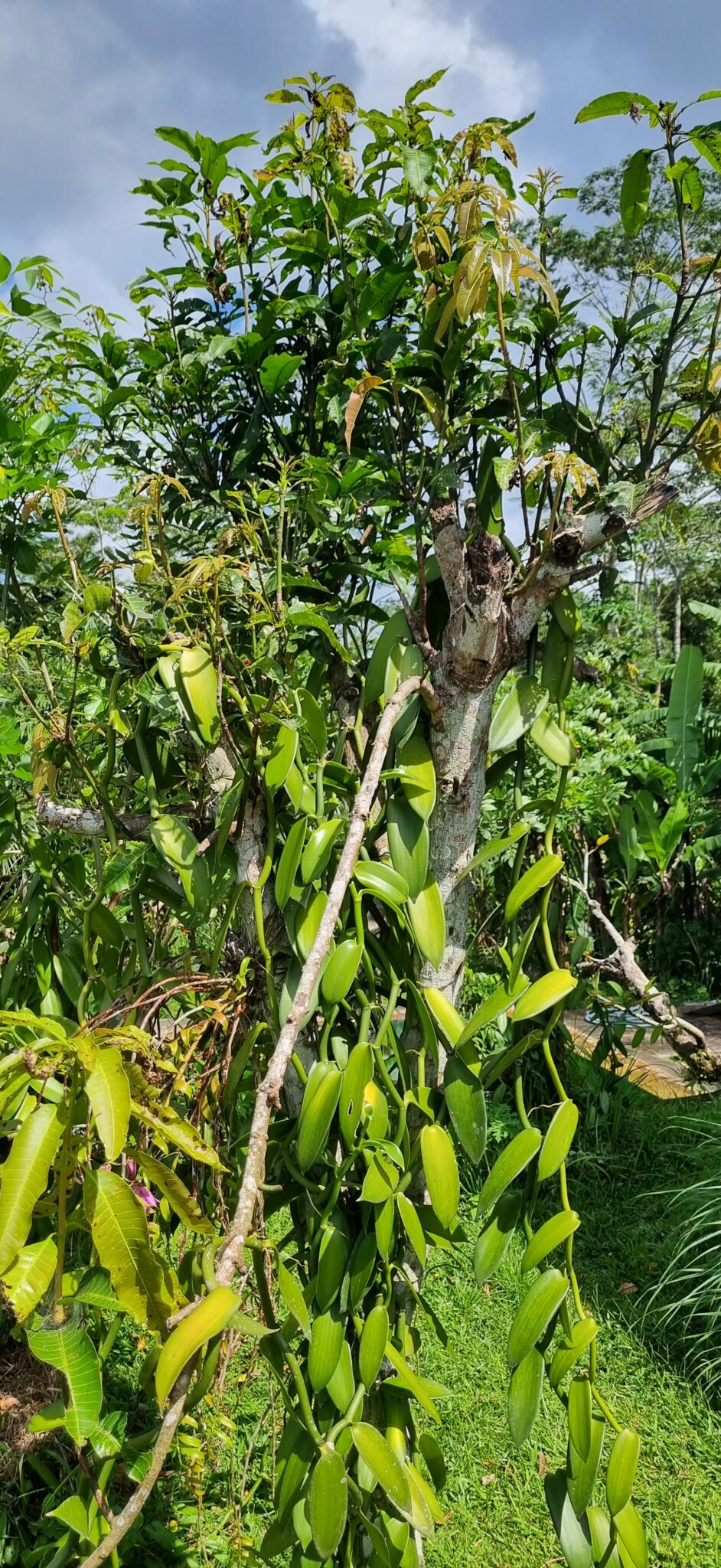
We experiment all the time, and having over 40,000 vanilla vines allows us considerable luxury in trying different things. Essentially, I try something new in my garden, and when and if it pans out, we try it in a new garden. Sometimes it is spectacularly successful, and we amend existing gardens. But the reality is that we currently have 25 gardens, and everyone is different! A luxury, because we can continue to monitor different responses to different climatic conditions.
Now, everyone knows that vanilla is a vine that lives in the dark rainforest, and needs lots of shade, right? So, we let our shade trees, Gliciridia, grow for at least 3 months before putting young vanilla at their base. We experimented with a shade house, so we didn’t have to wait. Expensive, that shade house. In fact, we built two, but the second became an aviary for us to breed rare birds for release at the same time as raising vanilla. It didn’t take long before we stripped the shade netting off the shade houses as the vanilla simply did not like so much shade.
We still didn’t twig, and it wasn’t until I pollarded a mango tree to control disease (pollarding is to cut a tree back to about 3m high) and the stump was eagerly seized by a nearby vanilla, that I began to wonder. Within 6 months, this vanilla in 70% sun was the biggest we had anywhere. I wasn’t sure whether it was the sun or the extra height, but both together are a killer combination. I have others at 3m and they are ok, but thinner and the leaves further apart. I have others that are shorter and in 60% sun, not so strong. One of these started to go from thick to thin, so I pruned the shading above and he thickened out again.
Some of our vanilla in the aviary wasn’t doing well, so I hauled it out and put it against frangipani trees, pruned, in full sun. Oh, not happy! This sudden move was definitely not appreciated. But one put out a shoot, which has now grown 4m up a Singapore cherry stump in full sunshine. Still not thick, but it only has the one shoot at present and it is usually after at least one loop that they get thick.
This experiment has only been running for 6 months, and it needs 3 years at least to be conclusive, but early signs are that we can totally change the way we grow vanilla (well, totally to us, though outsiders may be pushed to see a difference!). We have achieved this during the La Nina years, where we haven’t seen much sunshine. In a normal year, will it survive the full sun? It seems to like it, which implies it must have a good root system in amongst the dead cherry roots.
Young plants put at the base of trees in full sun, but initially protected, do well. They charge up the tree. Failure rate is higher than in shade, but the plants that succeed are stronger.
Of course, this experiment naturally leads to another – host trees and their shape. We are already allowing the Gliciridia to grow higher with excellent results – the staff haven’t complained yet nor asked for new tools, so they are managing above their heads! I do think we shall have to supply them with long handled secateurs and saws on sticks. In the meantime, I am planting a variety of other trees, especially looking at those with a cash crop, and seeing how they manage with vanilla. Those looking like failures are citrus, thorny and too much disease; morenga, needs lower altitudes; and a bunch that are just too slow in growing. Successes appear to be avocado, durian, mulberry, Singapore cherry (though the fruit is not commercial), guava, frangipani (no fruit but excellent pruning fortitude). Still not sure include apples and pear, not looking good as too slow, Australian plum, fruit not exciting, and a few others. Promising are the Amazonian butternut, ice cream bean tree, clove, cinnamon and macadamia. We have a number of native fruit trees which may or may not be interesting. Mango and mangosteen are head scratching, because they produce huge trees with dense canopy, but we can prune up them to a certain extent and I am just not sure. Left field are the sugar palm, aren, and the oil palm. Both exciting, because they offer the promise of transforming their industries. Again huge trees, but the vanilla loves the crevices in the trunks.
Coming back to the purpose of the light experiment, let us look at the wild vanilla. Yes, it does grow in the dark of the rainforest. But it does its best to get out as fast as possible! It shoots up a host tree and out of the canopy into full sun, only then does it think about bearing flowers and fruit. It will be interesting to see in the years to come the difference in yield and quality for our full sun grown vanilla.
Rex Sumner
Chairman at PT Royal Spice Gardens
Royal Spice Gardens is an Indonesian Foreign Investment Company, in Indonesia known as a Perusahaan Modal Asing (PMA).
NIB Licence number 0220100502286. NPWP: 94.830.504.0- 905.000.
PT Royal Spice Gardens Indonesia, Jl. Raya Pejeng, Tampaksiring, Gianyar, Bali 80552, Indonesia
Website by Simia Solutions / Cre8 Design Studio
Powered by Pak Kriss’s Compliance Framework.
Even in uncertain times, credible, stable & realistic opportunities are available for the astute investor.
Get the edge by obtaining clear, concise and rapid information. Fill out the form to receive our latest prospectus!